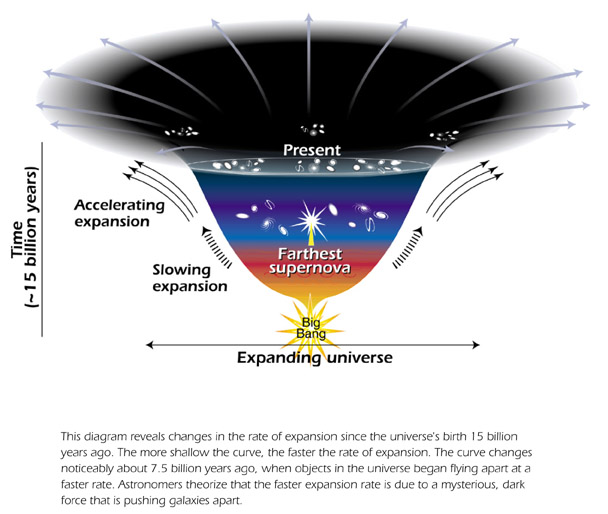
Until the mid-1990s accepted scientific understanding of the universe held that the cosmos was expanding. Scientists have accepted this since 1929 when Edwin Hubble‘s celestial observations showed that distant galaxies were all apparently moving away from us.
But, in 1998 two independent groups of cosmologists made a startling finding. The universe was not only expanding, its expansion was accelerating. Recent studies show that this acceleration in the fabric of spacetime is actually faster than first theorized and observed.
And, nobody knows why. This expansion, indeed the accelerating expansion, remains one of our current great scientific mysteries.
Cosmologists, astronomers and theoreticians of all stripes have proposed no shortage of possible explanations. But, there is still scant observational evidence to support any of the leading theories. The most popular revolves around the peculiar idea of dark energy.
From Scientific American:
Our universe is flying apart, with galaxies moving away from each other faster each moment than they were the moment before. Scientists have known about this acceleration since the late 1990s, but whatever is causing it—dubbed dark energy—remains a mystery. Now the latest measurement of how fast the cosmos is growing thickens the plot further: The universe appears to be ballooning more quickly than it should be, even after accounting for the accelerating expansion caused by dark energy.
Scientists came to this conclusion after comparing their new measurement of the cosmic expansion rate, called the Hubble constant, to predictions of what the Hubble constant should be based on evidence from the early universe. The puzzling conflict—which was hinted at in earlier data and confirmed in the new calculation—means that either one or both of the measurements are flawed, or that dark energy or some other aspect of nature acts differently than we think.
“The bottom line is that the universe looks like it’s expanding about eight percent faster than you would have expected based on how it looked in its youth and how we expect it to evolve,” says study leader Adam Riess of the Space Telescope Science Institute in Baltimore, Md. “We have to take this pretty darn seriously.” He and his colleagues described their findings, based on observations from the Hubble Space Telescope, in a paper submitted last week to the Astrophysical Journal and posted on the preprint server arXiv.
One of the most exciting possibilities is that dark energy is even stranger than the leading theory suggests. Most observations support the idea that dark energy behaves like a “cosmological constant,” a term Albert Einstein inserted into his equations of general relativity and later removed. This kind of dark energy would arise from empty space, which, according to quantum mechanics, is not empty at all, but rather filled with pairs of “virtual” particles and antiparticles that constantly pop in and out of existence. These virtual particles would carry energy, which in turn might exert a kind of negative gravity that pushes everything in the universe outward.
Read the entire story here.
Image: The universe’s accelerated expansion. Courtesy: NASA and ESA.
